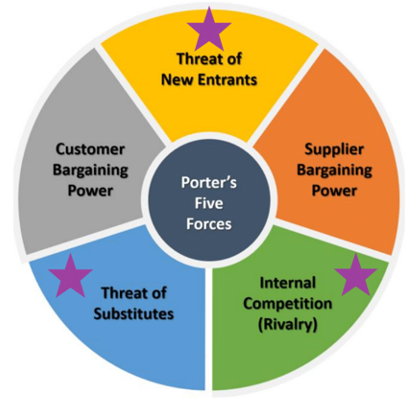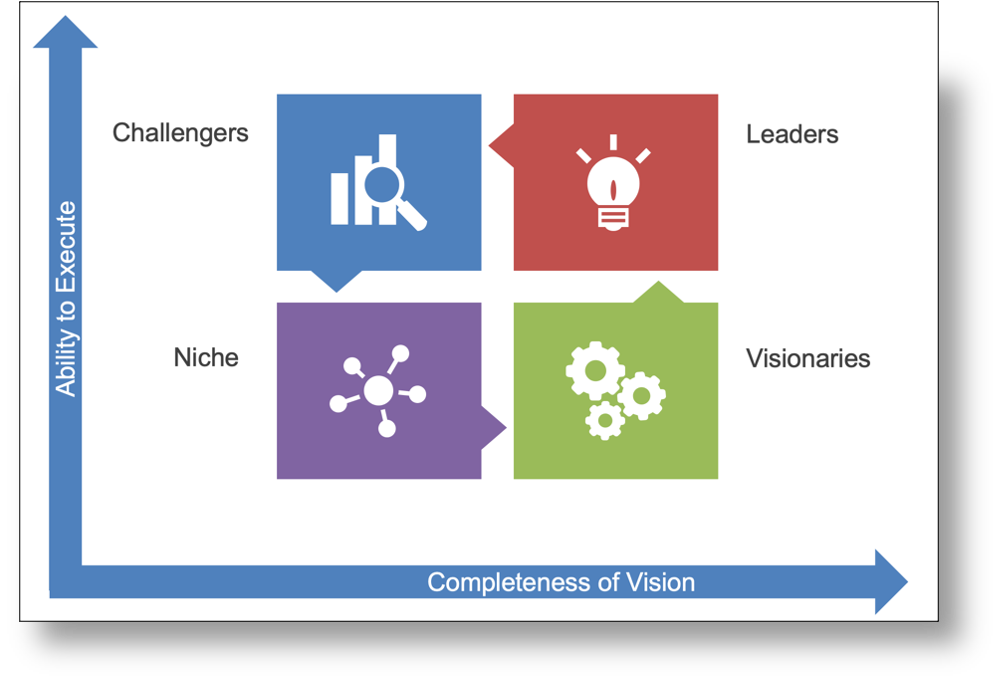Posted in Blog, Entrepreneurship, Grow, Innovation, Intrapreneurship, Launch Your Business by Jo North
How to do competitor analysis
When launching a new product or service, or updating your existing product or service portfolio, conducting a thorough competitive analysis is a crucial first step in developing a successful business strategy.
Competitive analysis involves identifying and evaluating the strengths and weaknesses of competitors and the competitive landscape in which your business operates. By conducting a thorough competitive analysis, you can gain valuable information about your own product offerings, customer experience, and marketing efforts, as well as those of your competitors.
This article is packed with practical tips on competitor analysis for your business and how to use competitor to support innovation and growth in your business.
What is competitor analysis in business?
Competitor analysis evaluates the strengths and weaknesses of your competitors’ current strategies to help identify opportunities and threats for your business to enhance your own strategy.
When seen through a customer-focused lens, competitor analysis is not about head-to-head comparisons, instead, it’s about assessing how much better or worse a product or service is at helping your customer get a job done.
Why is competitor analysis important for your business?
Competitor analysis can help you to sharpen and define our value proposition. It can also help you level up and do an even better job for your target customers.
“If you know the enemy and know yourself, you need not fear a hundred battles.”
Sun Tzu
Staying ahead of the curve
The world around us is always changing.
As social needs, technology, the economy, politics and environment change, so do customer needs and competitor activity. It’s essential that your business stays current, relevant and competitive. Watching for emergent trends and changes is vital for sustainable business business.
Examples of how the world around us is changing for 2023
Let’s take a quick look at some recent trends from the Mintel Global Trends Report for 2023. These trends are what today’s consumers are expecting and aspiring towards in the marketplace. It’s worth checking out the full, free Mintel report for yourself. You can download it here. As a summary, the trends for 2023 include:
Me Mentality
Consumers will be eager to re-focus on themselves and brands can help them take centre stage.
Power to the People
Brands have to make room for a new ‘c’ in their c-suite as, consumers are investing, co-creating and voting for change alongside brands.
Hyper Fatigue
Consumers will try to cut through the noise and connect with what matters to them.
International Localism
Buying local will be a way consumers can protect themselves financially, environmentally and psychologically, and feel that they are giving back.
Intentional Spending
Factors like flexibility, durability and sustainability will play increasingly important roles in consumers’ value equation.
Why are trends important?
So, why these trends are important? Because the world’s always changing and so are your customer’s needs! Customer activity is changing, and your business needs to keep innovating and changing in order to respond appropriately.
Competitor analysis sits in the context of the change around us.
If we don’t look at what’s going on around us, we start to drift away from where we need to be in the marketplace. This is called “strategic drift”. It happens to businesses that are complacent, inappropriately traditional, similar to many others. Customers aren’t wowed with the products and services, and there is alack of innovation and change.
Disrupt, or be disrupted!
Some benefits of customer analysis
By looking outwards and around at what your competitors are up to, you’ll get important insights that will help to achieve all of the following for your business:
- Nail down or create your unique selling proposition (USP)
- Better understand current market trends
- Better target your current customer base
- Uncover untapped markets that your competitors aren’t selling to
- Gather benchmark data to measure your growth against
- Find errors and gaps in your competitors’ strategies
- Identify your Unfair Advantage
You’re looking for learning to create opportunity.
Customer analysis is not about copying – it’s about outperforming, finding gaps and opportunities for innovation and growth.
Customer analysis is all about healthy learning, a growth mindset, and looking at where you can realistically do better.
Be savvy.
Avoid comparisonitis! Sometimes competitors’ performance might look much better than it really is, especially on their own websites and social media posts. Take what they say with a pinch of salt, as the reality is that nothing is ever perfect in business.
Get started with my 7-step competitor analysis process
Here’s how to do a competitor analysis for your business in 7 steps:
- Identify your competitors
- Review how your products & services compare with those of your competitors
- Work out what additional intelligence you need on your competitors and why
- Get the competitor intelligence you need
- Combine the competitor intelligence with customer needs and trends
- Identify gaps and opportunities for innovation and competitive advantage in your own business
- Create and communicate competitive differentiation for your own business
We will go through each of these steps in turn now.
1. Identify your competitors
I see many businesses dive into doing a competitor analysis, yet they’ve not considered who they’re competing with. Which competitors do you need to analyze, and why?
To conduct a competitive analysis, the first step is to identify the main competitors in your geographic area, market segment, or industry. This can be done through a Google search, market research, or by analyzing the market share of your industry’s top competitors. Once you have identified the list of competitors, the next step is to gather information about their product features, marketing strategies, sales volume, customer satisfaction, and online presence.
To get a closer look at competitors, visit their websites, review their product offerings, and read their customer reviews.
Include indirect competition in your analysis
In addition to analyzing your top competitors, it’s important to consider indirect competitors and similar businesses or brands that offer similar products or services. This can be done through a thorough competitive analysis framework or a competitor analysis template.
Think of this in terms of 3 of Porter’s Five Forces.

The first of the 3 areas to analyze is direct rivals.
Who is in your market already? Who are your competitors?
Let’s say you have a pizza restaurant that also offers takeaway. Ask yourself who your direct rivals are. In the pizza business, they may be other pizza takeaways that operate in the same location or environment.
You also need to look at what substitutes are available to your customers. A substitute is something that your product or service could be replaced with. In the example of the business business, this could be be a supermarket pizza cooked at home, an Indian or Chinese takeaway, or a pub meal.
Next, think about who the new potential competitors are that are entering the market. Is there a new pizza restaurant or other food and drink provider opening up in your locale?
And last, but not least, look to see if you are in a ‘blue ocean’ market. This is a space that is wide open. You enjoy an unrivalled market position that none of your competitors are in.
We can also look at it this way…
Primary, secondary and tertiary competitors
Primary competitors
- These are direct competitors. They are targeting the same audience or have a similar product as you — or both.
Secondary competitors
- These competitors may offer a high- or low-end version of your product or service, or sell something similar to a completely different audience.
Tertiary competitors
- These competitors offer products and services related to yours that are trending. They include businesses that it may be beneficial to you to collaborate with further down the line.
Again, looking at the pizza restaurant as an example…
- The primary competition is other takeaways.
- The secondary competition might be the lower-end pizza restaurant, or the five-star Italian restaurant.
- The tertiary competition are potential collaborators. In this example, it could be the businesses selling wine, or an ice cream parlor. You could collaborate and have an offer around pizza, wine, and ice cream! Yum!
Where do you stand in relation to your competitors?
I find it helpful to use Gartner’s Magic Quadrants to carry out a competitor analysis that shows where a business is positioned in relation to the wider market. It’s designed for technology products, but works for many other product and service sectors, too.

In this image you see on the horizontal axis is for the completeness of vision that your competitor has, and the vertical axis is the ability of your competitor to execute that vision.
This drives out different categories of competition, so this can be used to determine how you can classify your competition.
A visionary has a really well-developed vision, but is still working out how to get there. They know where they’re going, but they haven’t nailed it yet in terms of putting those ideas into practice.
Leaders, on the other hand, have that completeness of vision. They know where they’re going and they’re leading the pack.
Apple is a great example of this. They have a complete, clear and compelling vision. They also have the money, time, resources, processes, marketing, and so on to get behind that vision and make it happen.
A niche business is where one that has a smaller, very specific vision, as well as a limited ability to execute in a way that influences and disrupts the wider market.
Challengers are those that have got a good power behind them in terms of their operations and resources, but they’re not as visionary as the others. They do, however, have the ability to deliver.
We’ve seen this with Samsung over recent years. While they didn’t have the original vision, they had all the resources and technology to create a vision and compete with Apple and have come out as strong challengers.
2. Review how your products and services compare with those of your competitors
On occasion I have a business tell me that they do not have competitors, that nobody else is doing anything like they’re doing. This causes me to think that one of following applies…
- They have not looked properly.
- They’re really onto a winner. If nobody’s doing it, and there’s a cracking space there, go for it!
- There may not be any demand for it, and it will be very hard to create any demand for it.
If there’s no competition around, ask why that is. Have you looked and thought about it properly? Is it a real opportunity? Or is it a situation where there is no demand for what you’re looking to create and sell. Test it to find out if there could be some demand or not.
Structure your analysis
Do a structured analysis of how your business’ products or services compare to your primary competitors.
Perform a comparison on price, quality, innovation, customer service, and speed using specific evidenced information vs. just your perception.
3. Work out what additional intelligence you need on your competitors and why
To gain a better understanding of the competitive landscape, it’s also important to research industry trends, upcoming threats, and new trends in the market. This can be done by reviewing press releases, case studies, and industry reports.
When conducting a competitive analysis, it’s important to take a comprehensive approach and analyze all aspects of your competitors’ products, marketing campaigns, and marketing efforts. This includes analyzing their social media presence and social media competitor analysis, as well as their share of voice in the market.
Identify your information gaps
Start by identifying any gaps in your information on your competitors.
Is there any additional intelligence on those competitors that you feel you need? Make a note of that and determine how you might obtain that intelligence.
When you’re thinking about customer analysis, think about the customer journey from beginning to end.
- How is that business is making itself known?
- In what ways is it getting customers interested?
- How are they hooking them in and getting them into the sales funnel so that customers will buy?
- What is the purchase process is like?
- How are they retaining their customers?
- How are they getting customer recommendations, testimonials, and referrals?
4. Get the competitor intelligence you need
There are multiple ways of getting easy access to useful intelligence for your competitor analysis. Here are just some examples. Use a combination of sources to get a really rounded picture of what your competitors are up to and how well their strategies are working for them.
- Industry research – public and paid
- Websites and social media channels
- Annual reports
- News mentions
- Online customer support threads and reviews
- Networking – with customers and peers
- Customer research
- Sales team feedback
- Mystery shopping
- Subscribe to blog posts, newsletters, etc.
- Monitor recruitment
- Niche organisations and online communities such as Facebook groups
5. Combine the competitor intelligence with customer needs and trends; and 6. Identify gaps and opportunities for innovation and competitive advantage in your own business
It’s also a good idea to conduct a SWOT analysis of your competitors’ strengths, weaknesses, opportunities, and threats. This can help identify their competitive edge and potential threats to your own product or service.
At this stage I actually like to do a S.O.A.R. analysis.
S.O.A.R. stands for:
- Strengths
- Opportunities
- Aspirations
- Results
It’s a nice alternative to a SWOT. In a S.O.A.R. analysis, the opportunities absorb the weaknesses and threats from a S.W.O.T.
SOAR is strengths-based, consistent with an approach known as ‘Appreciative Inquiry’. This focuses on achieving successful change management by identifying what is working well and then doing more of it, because people (and therefore organisations) will grow in whichever direction people focus their attention.
When conducting a SOAR analysis, the basic questions you need to answer are:
- What are my/our greatest strengths?
- Where are my/our best opportunities?
- How would I define imy/our preferred future, or aspiration
- What are the measurable results that will tell me/us, I’ve/we’ve achieved the vision of the future?
Look at your SOAR analysis in the round. Select the items that would make the most significant difference to your business, and that have the potential to become a motivational innovation and growth goal resulting from your competitor analysis.
7. Create and Communicate Competitive Differentiation
Step seven is all about creating your competitive differentiation. Look at what you can improve, how you can level up and then put the plan that you’ve created in steps five and six into action.
As you create and implement your plan, make sure to ask yourself these questions about your own competitive advantage:
- Can you sustain it?
- Is it distinctive?
- Can it be communicated clearly?
- Do customers value the distinction enough to pay for it?
It is important to note that with competitive differentiation, what you do must be sustainable. So, if you’re going for it, make sure that you can keep it up for the duration.
Finally, using the information gathered from the competitive analysis, the next step is to develop a marketing plan that targets potential customers and captures the audience’s attention. This can involve developing marketing strategies that differentiate your product from competitors’ products and highlight your company’s strengths.
By conducting a thorough competitive analysis, you can make informed business decisions and develop a business strategy that leads to business success. Utilizing the best competitor analysis tools, such as Momentive.ai, Similarweb, Brand24 and others, periodic competitor analysis, and following the best practices for competitive intelligence in this article, you can gain a competitive advantage in the market and promote your product or service in a way that meets the needs of your target audience.
As well, why not have a look at my earlier show that I did on How to Create Your Value Proposition which will help you with that as well.
Next steps
I hope you’ve enjoyed this article on how to do competitor analysis and found it informative and helpful. Do let me know what you think and ask me any questions on the subject using the comments area. I’d love to hear from you!
You might also like to check out the many free resources that I have here. Browse the free content studio and get the items that interest you for free!

